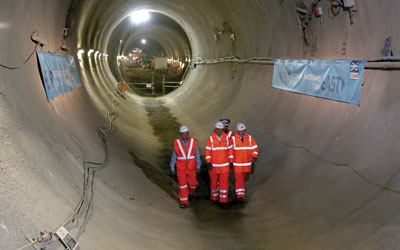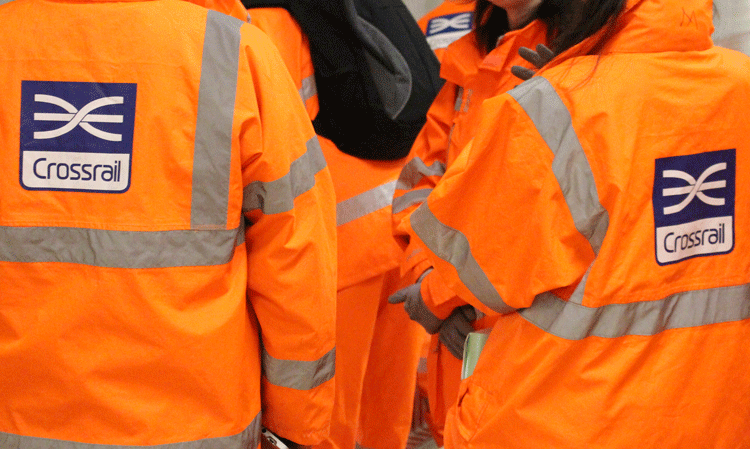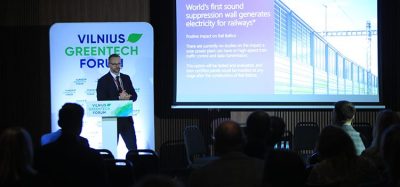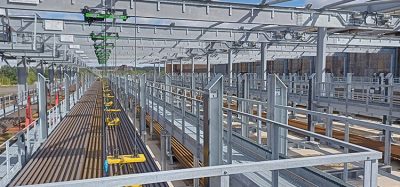Motivated and determined to deliver Crossrail
Posted: 9 December 2015 | | No comments yet
How is construction progressing on Crossrail – Europe’s biggest infrastructure project? Chris Enoch, Crossrail Railway Systems Project Manager gives Global Railway Review an update on works and what’s next for the ambitious £14.8 billion rail project to build a new east-west railway across London and the South East.


In May 2015, Crossrail celebrated a major milestone when the last of the eight 1,000-tonne tunnelling machines which were boring 26 miles of new rail tunnels underneath the capital, completed their journey at Farringdon Station. Farringdon is set to become one of the UK’s largest rail hubs with direct connections to London Underground and upgraded Thameslink services. UK Prime Minister David Cameron was joined by Transport Secretary Patrick McLoughlin and the Mayor of London at the station to mark the final breakthrough and the end of Crossrail’s tunnelling marathon.
Prime Minister David Cameron said: “Crossrail is an incredible feat of engineering that will help to improve the lives of working people in London and beyond. The project is a vital part of our long-term plan to build a more resilient economy by helping businesses to grow, compete and create jobs right along the supply chain.”
The construction of 10 new stations is progressing well. The Crossrail team’s focus is now on the task of delivering the infrastructure and railway systems to enable the service to start operating through central London and Docklands at the end of 2018. Crossrail will open fully in 2019. Construction work will now ramp up significantly within this highly complex and sophisticated systems fit-out phase, which involves fitting out the tunnels, portals, shafts and stations with all of the systems which are required to safely operate a world-class railway.
Up to 12,000 people will be working on the Crossrail programme at peak, with over 500 apprentices already engaged.
Transitioning to a Railway ‘Systems’ Focus
The project had previously been organised by geographical area, which was totally appropriate for tunnelling and civils works. To enable delivery during this critical railway systems phase, we have now transitioned into three sectors – Civils, Stations and Railway Systems. This recognises the fundamental point that systems traverse across geographical areas and need to be designed, installed and tested as such.
Crossrail’s Railway Systems
A dedicated team has been established to drive and manage the systems installation work, called ‘Railway Systems Delivery’. Many other Crossrail departments also provide crucial collaborative input and support to the Railway Systems teams to ensure that work is planned and executed to the desired safety and quality criteria.
The Railway Systems scope can be split into the following six primary elements:
1. Mainworks/tunnel fit-out
Track
This is by far the largest and most diverse Railway Systems contract. The initial phase includes the installation of over 40km of track, of which Crossrail will be using five different types. Over 80% of the track is Standard Track Slab (STS), comprising of long welded rail (delivered in 108m lengths) and around 70,000 sleepers which will be concreted into position using specialist fibre reinforced concrete.
Under some areas of central London where theatres and recording studios are located, the requirements to limit noise and vibration at the surface are strict. To deal with this, we have designed a highly specialist track form called ‘Floating Track Slab’ (FTS). This complex arrangement of rebar, concrete and mechanical devices actually ‘floats’ on a combination of elastomet rubber bearings and heavy duty springs to help absorb the noise generated by the rail/wheel interface. The track slab is constructed and then jacked up to accommodate the bearings and springs. A total of 3.4km of FTS will be installed on Crossrail
Due to the extra depth added by the spring base of the floating track, a shallower sleeper is needed. To ensure that this shallower sleeper remains durable and effectively minimises noise and vibration, an incredibly dense concrete called MagnaDense is used. MagnaDense is over twice as dense as normal concrete due to its natural iron ore content.
Prototype test tracks have recently been successfully completed to test and optimise the construction methods, materials and equipment.
There is also a short, 1.3km length of existing 140 year old tunnel in east London that we have refurbished. Because of the special nature of this tunnel, we have had to adopt a different track solution called Direct Fix Track (DFT). This track installation at Connaught Tunnel was completed in August 2015, some two weeks ahead of schedule.
Mechanical and Electrical Systems
This contract also includes provision of cable management systems, installation of over 1.5 million metres of cable, an emergency evacuation walkway, fire mains, drainage, lighting and other mechanical and electrical systems. It also includes the installation of an overhead catenary system that will be used to transfer power to the trains.
A key feature of the Crossrail system is the technologically advanced tunnel ventilation system. Huge vent fans will be installed at 18 locations across the scheme, and controlled via advanced, bespoke control systems. The objective of this system is to regulate tunnel pressure and temperature, and to provide smoke management control in the event of a fire.
Temporary Railheads
Finally, this contract includes the provision of two temporary railheads, required to stable, manage and maintain our large range of engineering trains which will be used during the next two years of construction. The largest railhead is located in the east at Plumstead, with a smaller but critical railhead in the west at Westbourne Park. Construction at Plumstead was completed ahead of schedule in June 2015, with Westbourne Park on plan to be finished by the end of 2015.
2. High Voltage (HV) Power
This package of work is to provide a stable, robust HV power feed to the entire infrastructure within the Crossrail system, particularly to the stations and the Traction Power systems that will ultimately power the trains. In simple terms, there are two ring-mains, one at 11kV and one at 22kV. In the central section, traction power for the Crossrail trains will be provided by two new bulk supply points from National Grid at Pudding Mill Lane in the east, and Kensal Green to the west.
3. Traction Power
The Traction Power contract provides the infrastructure required to provide a stable and robust +/- 25kV traction power supply to the overhead catenary, including transformers, regulators, switches, cables and other supporting periphery equipment.
4. Communications and Control Systems
The scope of works in this contract relates to key communications systems including station periphery devices such as CCTV, help points, PA announcement systems, customer information displays, staff and emergency services, radio systems and the data / SCADA networks that will carry information to and from the route control centre.
5. Platform screen doors
This covers the contract for the full height platform screen doors which will incorporate passenger information displays and space for advertising. The first prototype of the doors has been constructed at Knorr-Bremse’s facility in Melksham, Wiltshire. We are installing over 4km of platform screen doors.
6. Signalling and control systems
This is another very critical contract that includes the design, manufacture, supply, installation and testing of a sophisticated train control system for the central section of Crossrail. It will safely support 24 trains per hour between Paddington and Whitechapel during the peak.
Crossrail has opted for a Communications Based Train Control (CBTC) signalling system for the central section, as it is technically and operationally proven and successfully used by many metro systems around the world.


Our contractors
In addition to design, procurement and installation activities, the contractors are required to fully test and commission their systems. Crossrail is currently working with the contractors to develop a robust, integrated testing and commissioning regime to ensure that this phase is conducted robustly and optimally.
We have a range of skilled and experienced contractors who are responsible for the delivery of each of these contracts. In addition, the Crossrail supply chain is diverse with hundreds of supplier contracts executed to date in support of the Railway Systems programme. Many are UK-based firms.
The Railway Systems teams have recently co-located to the same office complex, to foster increased collaboration and integrated working between the Crossrail and our contractor colleagues.
How we are installing Crossrail’s Railway Systems
A dedicated fleet of bespoke machines will be used in the fit-out of the tunnels. Four technologically advanced, flexible and nimble Multi-Purpose Gantries (MPGs) have been specifically designed for Crossrail to perform a multitude of activities including sleeper and rail transportation and positioning and support to the concreting activities. Each gantry, operated by a single operator, will traverse along the raised curbed sides of the tunnel’s first stage concrete. The bespoke gantries have been manufactured for Crossrail by Metalliance in France.
Tata Steel has commenced deliveries to the Crossrail project, and will supply more than 57km of UK manufactured heat treated, wear-resistant rail. In total, 7,000 tonnes of Tata Steel rail will be used.
The concreting is a complex, precise process and utilises a dedicated 465m-long concreting train (that’s more than four football pitches in length!). This train is a sophisticated, mobile underground concrete batching factory, which is the reason for its significant length. Dry materials are loaded onto the concreting train which then batches the concrete.
The concreting train was refurbished and brought to the UK from France via the Channel Tunnel in August 2015 and is based at Plumstead. At its peak production rate, it will be able to install over 200m of concrete track slab each day.
Running and maintaining the concreting train is a 24 hour operation. Concrete pouring will take place during the night with restocking and maintenance being carried out during the day.
A series of other specialist trains, locos and equipment are also being used to install Crossrail’s railway systems including the overhead gantry, cable pulling and the drilling of over 250,000 holes for the required bracketry to support cable management systems and the evacuation walkway.
A state-of-the-art, precision automated drilling rig, which was manufactured by Rowa Tunnelling Logistics in Switzerland, will minimise the need for manual drilling. Once the track slab has been laid, the drilling rig will run on the newly laid track, leveraging state-of-the-art forward-looking 3D laser survey technology. The machine has a dust suppression system in place, producing a clean and accurate drilled hole every time.
When are we doing all this?
Work has already commenced with the systems fit-out. We are progressing on time and with a good safety record. The Railway Systems team has already completed the Plumstead Railhead (eight tracks), Connaught Tunnel Direct Fixed Track installation and multiple switch and crossings at Victoria Dock Portal. They are also progressing with the Standard Track Slab installation from Plumstead, and close to completing engineering design for all other areas. The Floating Track Slab installation works will commence in the field later in the year. The target is to complete all installation and static testing towards the end of 2017 so we can then start full dynamic testing.
This is a fast-track, complex, diverse and exhilarating project on many levels. A world-class project such as Crossrail attracts world-class people, leading to a blend of talented, inspirational professionals. This creates a rich, continuous learning ground for all, whatever your background. It’s a significant motivator for me and my team.
The Railway Systems team must deliver a complex programme of works, but I know our teams are skilled, motivated and determined to make it a success and to leave a legacy that everyone at Crossrail will be rightly proud of.
Crossrail values
Crossrail has a number of core values that underpin the projects decisions, activities and behaviours:
- Safety – we put safety first
- Inspiration – it’s in our power to change things for the better
- Respect – we treat people as we’d like to be treated
- Collaboration – we’re stronger together
- Integrity – we keep our promises
Crossrail quick overview – facts and figures
- Crossrail will transform rail transport in London and the south east, increasing central London rail capacity by 10%, supporting regeneration and cutting journey times across the city
- The Crossrail route will run over 100km from Reading and Heathrow in the west, through new tunnels under central London to Shenfield and Abbey Wood in the east
- There will be 40 Crossrail stations including 10 new stations at Paddington, Bond Street, Tottenham Court Road, Farringdon, Liverpool Street, Whitechapel, Canary Wharf, Custom House, Woolwich and Abbey Wood
- At its peak production rate Crossrail’s 465m-long concreting train will install up to 250m of concrete track slab a day
- Over 250,000 holes will be drilled by a state-of-the-art, precision automated drilling rig for the Crossrail tunnel fit-out
- Over 1.5 million metres of cable will be installed for Crossrail’s Mechanical and Electrical systems
- Up to 12,000 people will be working on the Crossrail programme at peak, with over 480 apprentices already engaged.
Biography
Chris Enoch has worked on the Crossrail project since 2013. He is the Project Manager of Crossrail’s Railway Systems Mainworks contract and responsible for ensuring that this major phase of the Crossrail project is delivered safely, on time and on budget. His team’s remit includes the design, installation and testing of track, drainage, cabling, fire, evacuation walkways, electrical systems, lighting, ventilation systems, overhead lines and 25kv traction power and extends to the construction of Crossrail’s railhead logistics centres. Chris also has an extensive and expanding Principle Contractor responsibility across the programme with over 1,200 people working on these contracts at peak.







